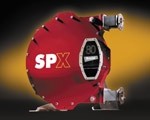Equipment that likes it and lumps it

Any parent will be familiar with children's yoghurts that boast about having 'no bits', but most of us develop a taste for lumpy food as we grow older. This leaves food manufacturers with a problem: how to move delicate solids around without smashing them into baby food.
The impellers in conventional centrifugal pumps whip process fluids around creating very high shear stresses. This is likely to turn any chunks into a puree, which doesn't go down too well with adult consumers.
"There's definitely a trend towards more recognisable processed food," says Martin Johnston, product manager with peristaltic pump manufacturer Watson Marlow Bredel. "People want products containing whole strawberries or cherries, for instance, and that takes careful handling."
And lumps are not the only types of food that can suffer unwanted stress during pumping. Take whipping cream, for example. Passing it through a centrifugal pump would ensure that it's whipped before it even leaves the production line.
So if centrifugal pumps are out, what are the alternatives and how do they measure up against each other? Today the market is dominated by positive displacement pumps, the most common of which are the lobe pumps.
"The UK food industry is so awash with them that we call it Lobeland," laughs Guy Glennon, md of Walsall-based Netzsch Pumps. Netzsch is best known for its progressing cavity pumps, but also includes lobe pumps in its range.
Lobe pumps use a lobed rotor housed in a stator to create chambers that capture and move portions of product around. This straightforward approach is successful in producing a low-shear flow that is fine for most applications.
Lobe pump disadvantages
Lobe pumps do have certain disadvantages, however. When handling viscous products, for example, the gap, or pinch, between the rotor and stator can sometimes be quite large. This effectively makes the cavities very 'leaky', which in turn makes lobe pumps bad at sucking. "Progressing cavity pumps (PCPs) have much better suction lift capabilities," says Glennon. "This also means they're capable of self-priming, which lobe pumps aren't."
Like lobe pumps, PCPs are positive displacement pumps. They contain a helical rotor inside a helical stator, which creates a chamber, or cavity, that carries a portion of the process fluid with it as it moves along the pump.
"The big advantage of a progressing cavity pump is very smooth flow -- there's no pulsation at all," says Glennon. This is important with highly viscous products, because pulsations can cause potentially damaging pressure surges down the pipeline. Some types of downstream equipment, such as static mixers, also need a steady flow to perform properly. Pulsations also cause shear stress that some products cannot tolerate.
Peristaltic pumps are increasingly important competitors to the lobe pumps and PCPs. They don't suffer from the potential sealing problems of their rivals, because they work by pushing the product through a flexible hose using external rollers. According to Johnston, peristaltic pumps produce the least shear stress of any of their rivals. "They were originally developed for pumping blood during dialysis because they cause very low rates of cellular damage."
But there's one thing that no positive displacement pump handles very well, and that's deadheading.
Deadheading is when a valve or blockage restricts the flow through the pump. This can be either accidental or intentional, for example, during dispensing operations. Instead of simply using a valve to control the delivery, these pumps need to be stopped and started for dispensing applications, which makes the control process more complex.
One contender that doesn't suffer from the deadheading problem is the air-operated double-diaphragm (AODD) pump. AODD pumps are split into two halves, which each operate in the same way: An oscillating diaphragm pulls the product through a non-return valve into the pumping chamber. As the diaphragm moves back the other way, it pushes the product out of the chamber through a second non-return valve.
"Almost all yoghurts are pumped using diaphragm pumps, lumps of fruit and all," says Richard Buddin, a director at Diaphragm Pumps, a distributor based in Stoke-on-Trent. "We stock models to pump whole oranges, viscous products up to 20,000 centipoise (cP) or even products up to 20,000cP containing whole oranges!" In one of the company's latest installations for bakery chain Greggs, for example, diaphragm pumps handle non-flowing pie fillings complete with chunks of meat.
Diaphragms
"Diaphragm pumps have a controllability that's hard to match," says Buddin. "An electric motor wants to turn no matter what you're doing. But with an air-driven diaphragm pump facing a restriction, the pressure in the process fluid rises until it matches the air pressure and then the pump just stops without doing any harm. Once the valve opens and the pressure drops it simply starts again."
But Buddin admits that their use of compressed air is also a disadvantage of AODD pumps in terms of energy efficiency: "It takes a 7.5kW compressor to do the job of a 0.75kW motor, but the controllability benefits far outweigh the drawbacks."
Johnston admits that peristaltic pumps do not respond well to deadheading, but says that some lumpy products are better in a peristaltic pump than an AODD, because the lumps can jam the AODD pump's valves.
For example, Hull-based Tryton Foods recently opted for peristaltic technology to handle its apple pie filling. Gordon Lockwood, project engineer at Tryton Foods, says: "We needed a big transfer pump, so we originally tested diaphragm pumps. They were not suitable because they became blocked up. The next step was to go for large peristaltic pumps, which were chosen in favour of volumetric pumps because they minimised damage to the product."
In addition to these well-established technologies, some less widespread technologies are also starting to make inroads into this specialist market.
For example, disc pump technology is a relatively modest player in the UK market. Instead of a conventional impeller that impacts on the process fluid, the disc impeller uses viscous drag from the surface of the disc to pull the fluid around. The US manufacturer, Discflo, boasts US installations pumping everything from orange pulp to whole chickens, and the pumps are available in the UK from distributor ESI Process.
In one application, Discflo pumps replaced positive displacement pumps that were having a problem dealing with unfiltered egg whites. The original pumps were fine for producing a low-shear action that prevented the product from foaming, but the rotors were wearing out every three months because of the abrasive fragments of shell in the egg white. Because disc impellers do not impinge on the product, they don't suffer in the same way and maintenance costs have been slashed, according to the pump company.
Recent arrival
A very recent arrival on the UK market is the Saniflo VC pump range, which is distributed by London-based Axflow. The pumps are another import from the US and are manufactured by Wilden Pumps. Coincidentally, company founder Jim Wilden was also responsible for inventing the original AODD pump, which celebrates its 50th anniversary this year. This latest innovation is also air-operated, but works in a slightly different way.
The heart of the pump is a vertical pumping column with two liquid check valves at its base. A controller draws air from the column to suck up the process fluid. It them reverses the air flow, pushing the fluid down the column and downstream.
Axflow says the Saniflo can pump products with compressible solids of up to 15cm without damage, and case studies from the US seem to support this claim. Existing food applications include pumping spinach, jam, hog intestines and even live sardines.
For example, when a fruit muffin maker faced problems with the quality of its batters, piston pumps were identified as the culprits. They were degrading the fruit and the juice from this degradation was tinting the batter.
Apart from product problems, the pumps themselves suffered from the abrasive nature of seeds and could not be allowed to run dry. As a result, the pumps required a dedicated maintenance engineer.
By swapping to a Wilden pump, the manufacturer was able to transfer up to 32kg/min of batter containing whole blueberries up to 16mm in diameter without any degradation of the fruit or batter. The end result was improved product quality and substantially reduced maintenance and spare parts cost.
But whatever technical innovations the pump manufacturers come up with, they'll need to work hard to crack this extremely conservative market. The landscape of 'Lobeland' is unlikely to change radically any time soon.FM
key contacts
- Axflow020 8579 2111
- Diaphragm Pumps01782 393939
- ESI Process01708 553999
- Netzsch Pumps01922 453433
- PCM Pumps01536 7402009
- Watson Marlow Bredel01326 370370














